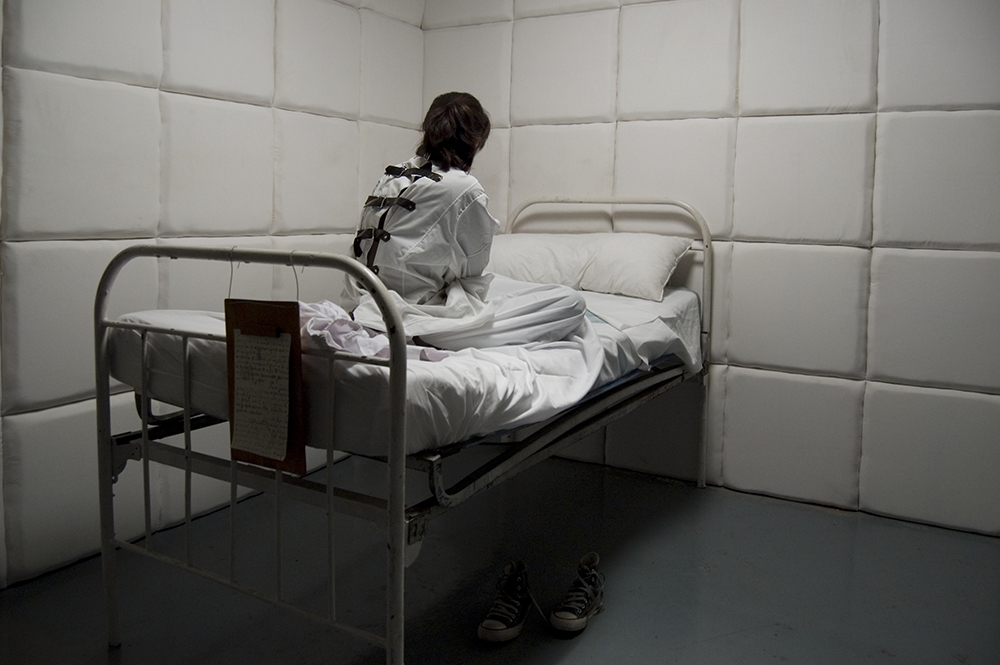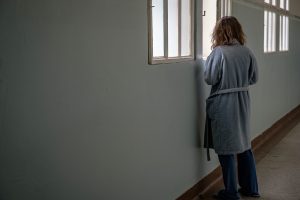Psychiatrists’ increasing reliance upon involuntary commitment in psychiatric facilities and forced mental health treatment has caused a litany of harm and human rights abuses—funded by billions of taxpayer dollars.
By CCHR International
January 23, 2023
Involuntary detention and forced treatment policies in the U.S. are unworkable and harmful. Moreover, they violate current World Health Organization (WHO) direction to end coercive psychiatric practices.[1] Increasing involuntary detention is a measure that states are being advised to take as a “solution” for everything from violence prevention to getting displaced persons forced into institutions. However, it is a failed, costly and often destructive policy—both for the individual and the community.
Involuntary commitment is a fate that can be worse than criminal incarceration—though in the case of a mental health commitment, the person has not committed a crime.
In the wake of acts of senseless violence, psychiatrists have also called for greater rights to involuntarily commit individuals—the antithesis of what the WHO is advocating—and a practice that has not been proven effective in stopping violence.
People who are subjected to coercive practices report feelings of dehumanization, disempowerment and being disrespected, according to WHO. The agency points to a series of United Nations guidelines and Human Rights Council resolutions that have called on countries to tackle the “unlawful or arbitrary institutionalization, overmedication and treatment practices [in the field of mental health] that fail to respect…autonomy, will and preferences.”[2]
An editorial in The Los Angeles Times pointed out that forcing the homeless into treatment is not a productive approach. “Forced treatment for substance abuse or mental illness is not effective,” it reported.[3]
According to a 2019 study, people who felt they were coerced into being hospitalized against their will were more likely to attempt suicide after being released from the hospital. A 2017 article in JAMA Psychiatry found that the risk of suicide was 100 times greater than average immediately after being released from a hospital. Involuntary hospitalization was associated with an increased risk of suicide both during and after hospitalization. [4]
“We know that delivering those services in a forced, institutional setting…actually has a very low success rate. It doesn’t result in people stabilizing over the long term,” said Anya Lawler, a policy advocate at the Western Center on Law and Poverty.[5]
Psychiatric hospitalization can especially put children and youths at high risk of being physically or sexually assaulted, drugged against their will, restrained, and killed, given the troubled teen behavioral industry’s history of harm.[6]
Forced Treatment is a Lucrative Business in the Mental Health Industry
A February 2022 report, “The Kids Are Not Alright: How Private Equity Profits Off of Behavioral Health Services for Vulnerable and At-Risk Youth,” revealed for-profit behavioral facilities have become a gravy train for investors in a $23-billion-a-year “child abuse” industry.[7]
Public insurance programs (e.g., Medicare, Medicaid) are the primary payers for approximately 60% of psychiatric hospital stays.[8]
Forcing treatment on the homeless or detaining people for longer periods in psychiatric institutions if they are deemed “violent” adds to the gravy train. According to the NYC Independent Budget Office, emergency shelters cost $138 a day on average for single adults, or more than $50,000 a year. Supportive housing costs between $25,000 and $36,000 per person per year. Cost estimates for a forced night in a hospital, meanwhile, range from about $1,100 to more than $3,000—equal to an annual expense of $400,000 to $1.1 million per person.[9]
In one high-profile celebrity case of forced treatment, it cost her $60,000 per month.[10]
As such, psychiatric facilities can profit greatly from an influx of displaced people or detaining individuals under the pretense that they may become violent. Already, an estimated 54% of admissions to psychiatric facilities in the U.S. are involuntary. As a December 2022 article headlined “And Now They Are Coming for the Unhoused: The Long Push to Expand Involuntary Treatment in America,” stated, “A lot of people get put away involuntarily. They get medicated immediately. And they can’t even fight back because they get medicated.”[11]
“A Comparative Study of the Right to Refuse Treatment in a Psychiatric Institution” notes “people with mental disabilities are subject to many types of behavioral therapies against their will, including medications and restraints. This is especially true of people who are institutionalized. These intrusions are in violation of fundamental international human rights principles. People with mental disabilities are often stripped of many of their basic rights, including the right to determine what is done to their bodies.”
Many studies document the violence- and suicide-inducing effects of both taking and withdrawing from psychotropic drugs, which are often forced on those who are involuntarily committed. CCHR’s report Psychiatric Drugs Create Violence & Suicide includes many of these studies. “Violence and other potentially criminal behavior caused by prescription drugs are medicine’s best kept secret,” says international psychopharmacology expert Prof. David Healy.[12]
Some courts have supported the right to refuse treatment based on the Fourth Amendment’s right of privacy and/or the substantive due process right to bodily integrity.[13]
In 2006, an Alaska Supreme Court decision against forced treatment acknowledged that psychotropic drugs “‘affect the mind, behavior, intellectual functions, perception, moods, and emotion’ and are known to cause a number of potentially devastating side effects….” It ruled against them being forced on a woman who sued a psychiatric institution over administering the drugs against her will.[14]
WHO acknowledges how the need to change forced mental health treatment policy may be daunting to governments. However, “Although challenging, it is important for countries…to eliminate practices that restrict the right to legal capacity, such as involuntary admission and treatment….”[15]
CCHR’s Mental Health Declaration of Human Rights includes many of the rights that the WHO report encompasses.
Get Legal Counsel for Recourse Against Involuntary Commitment and If You Are Forcefully Treated
You have the right to sue. A lawsuit may force an institution to pay damages for the loss of civil rights.[16]
- A Pennsylvania jury awarded an Oil City, Pennsylvania man more than $1.1 million in damages in a civil suit against Northwest Medical Center after he was falsely imprisoned for more than seven days. Roy E. Lund was committed against his will at the hospital for emergency mental examination and treatment after his wife phoned police alleging he had threatened her. According to the lawsuit, “the allegations which were the basis for Lund’s involuntary commitment were false.” “During Lund’s involuntary commitment at Northwest, psychological testing revealed Lund’s behavior was not consistent with allegations that Lund was rageful or assaultive,” the suit said.[17]
- A 28-year-old woman suffering from personal problems and the subsequent unexpected death of her son was involuntarily committed to a behavioral health center by a psychologist allegedly following a telephone conference in which the woman expressed suicidal ideation. The physician failed to document the specifics of the conversation on the records required for an involuntary commitment. The woman suffered mental anguish and was awarded $65,000.[18]
- Carol Jason, a 59-year-old former school board official in Marysville, Washington checked herself into BHC Fairfax Hospital (in Kirkland, WA) in March 2017 and, disgusted by what she saw inside, promptly asked to leave the psychiatric facility. Fairfax, which is owned by Universal Health Services—one of the largest mental health care providers in the nation—tried to have Jason involuntarily committed, even though a hospital assessment had found her judgment was good and risk of suicide low. The staff held her for four days against her will until a county official evaluated her—and found no grounds to commit her. After her case, the Seattle Times conducted an investigation of psychiatric hospitals holding voluntary patients against their will. The state Department of Health also investigated and found at least five hospitals held 17 voluntary patients when they should have been released.[19]
- Three Ohio facilities—Cambridge Behavioral Hospital, Ridgeview Behavioral Hospital, and The Woods at Parkside—were ordered to pay $10.25 million to resolve alleged violations of the False Claims Act for improperly admitting patients who did not require inpatient psychiatric treatment, resulting in the submission of false claims to the Medicare program.[20]
Find Law.com notes that most states require a court order within two to three days of an emergency confinement and a hearing within a few weeks. The patient has a right to an attorney during the hearing and often will be appointed one.
Civil commitment will generally be upheld if the court agrees that the patient is a danger to themselves and/or the community. But states must follow due process. This means you (or a loved one) have the right to defend against such an action in court. If in doubt, reach out to a local healthcare law attorney for guidance.
The U.S. Supreme Court decided in 1975 in the case O’Connor v. Donaldson that “A State cannot constitutionally confine… a non-dangerous individual who is capable of surviving safely in freedom by himself or with the help of willing and responsible family members or friends….”
This decision established the standard that a finding of “mental illness” alone is not enough to confine a patient against their will; they must also be either:
- A danger to the public (invoking the state’s inherent police powers); or
- A danger to themselves (the legal doctrine of “parens patriae“) (meaning “parent of the country,” where the government, or any other authority, is regarded as the legal protector of citizens unable to protect themselves)
Standards for involuntary treatment and confinement vary from state to state, although all patients are afforded protections under the federal Civil Rights of Institutionalized Persons Act of 1980 (CRIPA). While CRIPA doesn’t establish new rights for institutionalized persons, it provides for the investigation of complaints regarding the rights of patients (both voluntarily and involuntarily institutionalized).[21]
The Civil Rights of Institutionalized Persons Act (CRIPA) protects the civil rights of people confined in state- or locally-operated institutions. The mistreatment of people confined in facilities is a serious offense, and civil rights laws like CRIPA exist to protect them.
Private facilities, however, aren’t covered under the Act. The CRIPA process begins when the Department of Justice receives reports of civil rights abuses within a publicly-run institution (jails and prisons, juvenile correctional facilities, state or locally-run mental health facilities; state- or locally-run developmental disability and mental retardation facilities; state- or locally-run nursing homes). The case is usually assigned to an investigator with the U.S. Department of Justice (DOJ), who then begins to research the claims of abuse. Investigations usually include site visits, document production, interviews with inmates and family members, and anything else the case workers request. If no civil rights violation is found, the case is closed.
Since it’s in the best interests of both the institution and the DOJ to avoid a lawsuit, the DOJ will typically work with the institution to correct the errors. However, if these efforts are unsuccessful, the DOJ will bring a lawsuit against the institution. Unlike in most federal lawsuits, the court cannot award money in a CRIPA suit. Instead, the only remedy a court can offer is to order an injunction forcing the institution to change the offending practices.[22]
According to another website, “Being wrongfully committed can be scary, dangerous, and harmful to an individual that doesn’t need to be there. It’s also a violation of your constitutional rights. If you believe you’ve been wrongfully committed to a hospital or in-patient facility, you may be able to sue for wrongful involuntary commitment in small claims court.”
“Being falsely imprisoned can result in a lot of mental pain and suffering. You’ll have to live with the social stigma of being on an emergency psychiatric hold. You may also suffer from any false testimony given against you that resulted in the involuntary hold. This can result in making it more difficult to retain custody of your children or even find safe housing in the future.”[23]
As such, seek legal counsel to take action against forced psychiatric treatment.

[1] https://www.cchrint.org/2021/06/11/world-health-organization-new-guidelines-are-vital-to-end-coercive-psychiatric-practices-abuse/, “Guidance on Community Mental Health Services: Promoting Person-Centered and Rights-Based Approaches,” World Health Organization, 10 June 2021, https://www.who.int/publications/i/item/9789240025707 (to download report)
[2] https://www.cchrint.org/2021/06/11/world-health-organization-new-guidelines-are-vital-to-end-coercive-psychiatric-practices-abuse/; Op. cit., World Health Organization, 10 June 2021, pp. 5, 8
[3] “Editorial: Forcing homeless people into mental health treatment isn’t the way to solve homelessness,” Los Angeles Times, 28 Jan 2022, https://www.latimes.com/opinion/story/2020-01-28/homeless-people-mental-health-treatment-homelessness
[4] https://www.madinamerica.com/2019/06/involuntary-hospitalization-increases-risk-suicide-study-finds/
[5] Ibid.
[6] https://www.cchrint.org/2022/12/16/cchr-reviews-a-year-of-child-abuse-allegations-against-troubled-teen-behavioral-institutions/
[7] https://www.cchrint.org/2022/12/16/cchr-reviews-a-year-of-child-abuse-allegations-against-troubled-teen-behavioral-institutions/; The Kids Are Not Alright: How Private Equity Profits Off of Behavioral Health Services for Vulnerable and At-Risk Youth,” Private Equity Stakeholder Project, 17 Feb. 2022, https://pestakeholder.org/wp-content/uploads/2022/02/PESP_Youth_BH_Report_2022.pdf, p. 21; https://www.breakingcodesilence.org/acca/policy-memo/
[8] https://www.cchrint.org/2022/07/11/billions-spent-on-violence-prevention-ignores-how-psychotropic-drugs-cause-hostility/ “Involuntary Commitments: Billing Patients for Forced Psychiatric Care,” The American Journ. of Psychiatry, 1 Dec. 2020, https://ajp.psychiatryonline.org/doi/10.1176/appi.ajp.2020.20030319
[9] Annalisa Merelli, “NYC’s new plan to forcibly hospitalize homeless people is a waste of taxpayer money,” Quartz, 3 Dec. 2022, https://qz.com/nycs-new-plan-to-forcibly-hospitalize-homeless-people-i-1849843872
[10] https://www.npr.org/sections/health-shots/2021/09/27/1040552033/involuntary-psychiatric-hold-cost-britney-spears
[11] https://www.madinamerica.com/2022/12/unhoused-expand-involuntary-treatment/
[12] https://www.cchrint.org/2020/06/01/drug-induced-acts-of-senseless-violence-need-investigation/; https://rxisk.org/prescription-drug-induced-violence-medicines-best-kept-secret/
[13] Mehgan Gallagher, “A Comparative Study of the Right to Refuse Treatment in a Psychiatric Institution,” Cambridge University Press, 8 Sept. 2016, https://www.cambridge.org/core/journals/international-journal-of-legal-information/article/no-means-no-or-does-it-a-comparative-study-of-the-right-to-refuse-treatment-in-a-psychiatric-institution/611A04C256D173CCF94CD260E52D484E
[14] https://www.cchrint.org/2022/07/11/billions-spent-on-violence-prevention-ignores-how-psychotropic-drugs-cause-hostility/ Faith Myers vs. Alaska Psychiatric Institute, Supreme Court, 2-11021, Superior Court No. 3AN-03-00277, Opinion, No. 6021, 30 June 2006, https://caselaw.findlaw.com/ak-supreme-court/1004032.html
[15] https://www.cchrint.org/2021/06/11/world-health-organization-new-guidelines-are-vital-to-end-coercive-psychiatric-practices-abuse/; Op. cit., World Health Organization, 10 June 2021, p. 6
[16] https://www.findlaw.com/civilrights/other-constitutional-rights/civil-rights-of-institutionalized-persons.html
[17] http://www.psychcrime.org/news/index.php?vd=944&t=Noteworthy+case%3A+Pennsylvania+man+awarded+%241.1+million+for+involuntary+commitment+%282003%29, Michelle Sottiaux, “Man awarded $1.1 million in suit against hospital,” Oil City Derrick, June 17, 2003
[18] https://www.reliasmedia.com/articles/130156-woman-involuntarily-committed-suffers-mental-anguish-8212-65-000-verdict-awarded
[19] Daniel Gilbert, “Woman’s legal quest illuminates the rights of hospital patients who want to leave,” Seattle Times, 27 Oc. 2022, https://www.seattletimes.com/seattle-news/times-watchdog/one-womans-legal-quest-illuminates-the-rights-of-hospital-patients-who-want-to-leave/
[20] https://www.justice.gov/opa/pr/ohio-treatment-facilities-and-corporate-parent-agree-pay-1025-million-resolve-false-claims
[21] https://www.findlaw.com/healthcare/patient-rights/involuntary-commitment-patient-and-public-rights.html
[22] https://www.findlaw.com/civilrights/other-constitutional-rights/civil-rights-of-institutionalized-persons.html
[23] https://donotpay.com/learn/suing-for-wrongful-involuntary-commitment/





